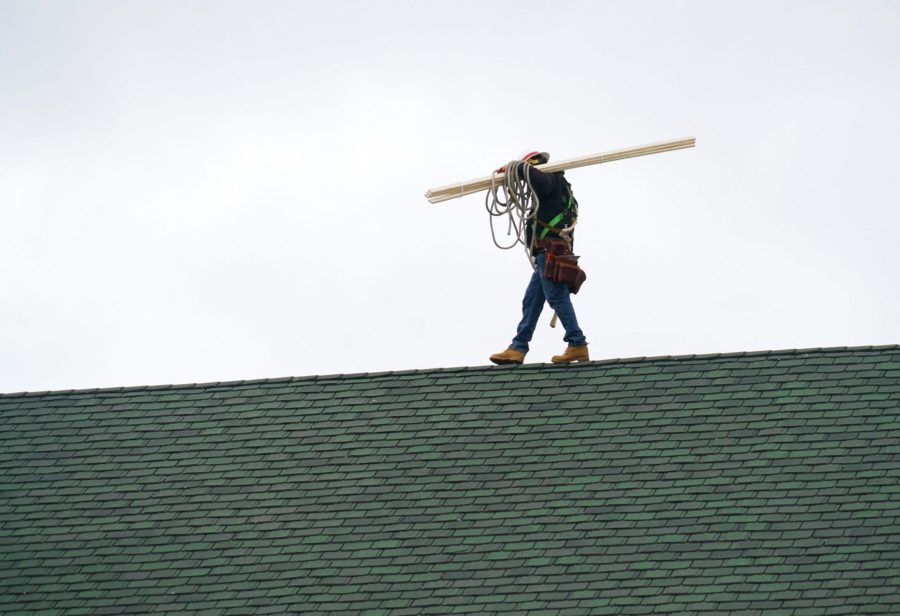There are some instances where you may need to climb on top of your house. For example, hanging up Christmas lights in December. When you find yourself in this situation, you want to be prepared to climb up 15-30 feet. You also want to follow roof safety to prevent taking dangerous risks.
When you’re preparing for a project, you might find yourself asking this important question: how much weight can my roof support? The answer is simple, but it depends on a few factors.
We created a guide to help you determine if it can hold your weight. America’s Choice Roofing provides the knowledge and safety for homeowners to properly care for their homes.
Is it Safe to Walk on the Roof?
The short answer is yes. It’s designed to withstand the combined weight of a temporary live load and a dead load to retain structural integrity. A clay tile or metal roof can hold a dead load of approximately 27 pounds per square foot.
Pounds Per Square Foot
Your structural documents should indicate the specific amount of weight your roof can support but the age of your home and any additions can dispute the information. Typically, 20 pounds per square foot is the expectation.
Building codes will give you a general idea of how much weight per square inch can be distributed. The load for normal shingled or wooden roofs follows the same code.
With that in mind, the code typically starts out at 20 pounds per square foot. Residential roofs can hold a minimum of around 20 pounds per square foot then top out at 100 pounds per square foot.
Is My Roof Strong Enough to Hold My Weight?
As long as the weight capacity is not exceeded, it can hold your weight and you can safely walk across the surface. Keep in mind, it’s recommended to stay off the top of any building unless you’re a professional.
Building codes set minimum standards for roof load-bearing capacity but elements including age and weathering can affect how much weight it can realistically hold. Newer roofing materials also tend to weigh more than older ones, causing more stress on the overall surface.
Signs Your Roof Might Not Be Able to Hold You
If you want to ensure your roof structure is stable, you want to have preventative measures in place. Preventative measures will guarantee your roof’s strength while experiencing foot traffic. Some of the most common signs it might be stable are:
Your Roof is Sagging
One of the first signs of an unstable structure is sagging. Structural damage typically happens over time and it won’t collapse in one piece. If you notice signs of a potential collapse, you need to have a structural engineer and a contractor have a look at it right away. If the surface feels springy, spongy, or soft under concentrated weight, you need to get off immediately.
You Notice Cracks in Your Ceiling
Cracks in the ceiling or the brickwork are a sign of an underlying problem and could mean it is being stressed and spreading outward. The culprit of cracks can not always be seen by the naked eye and could be the result of leaks. Do not wait until the damage spreads further along the interior walls.
You Can See Weather Damage
Different roofing materials will weather at a different rate, so it’s crucial you receive an inspection once a year. Asphalt shingles are not the most durable material, but they still protect your home in a storm.
Living somewhere that experiences heavy snow and adverse weather is a reason to upgrade to a more sturdy material like metal to prevent costly weather damage.

How Do I Strengthen My Roof?
Now that you know how much weight your home can hold, there are some ways to strengthen it. Unless it is old or in need of reinstallation, there are some preventative measures you can take to reinforce how much weight it can hold. You can even add more weight without causing additional strain.
Attach Trusses to the Wall
One way to enhance your roof support is by adding trusses. This can only be done in certain areas because the average roof doesn’t support access to all points of the interior structure. However, you should be able to access the attic and the interior walls. Attaching more trusses will increase how much weight your roof can support.
Repair Damaged Shingles
Asphalt shingles are the most common roofing material. Sometimes you will need to repair or replace damaged shingles that have curled or chipped to keep moisture out and prevent rotting.
America’s Choice Roofing can help repair damage to your home after experiencing high winds. Don’t hesitate to give us a call so you can have some peace of mind.
Strengthen Existing Trusses
Strengthening trusses increases the stability and how much weight it can withstand. Use 2x4s and simply combine them with the existing trusses from one end of your home to the other. The additional support will compensate for abnormal weight or dead loads.
Protect it from Ice and Snow
How much snow it can support depends on the type. Light snow can already weigh as much as 3 pounds per square foot. There is a huge range when it comes to the weight of snow, so the structure needs to be capable of holding over 6 feet of it. The more weight, the harder it is for your home to support it.
You also need to be on the lookout for ice dams. This occurs when your water and ice accumulate at the bottom with nowhere to go. Give America’s Choice Roofing a call to help prevent ice dams from stopping your ventilation when snow has accumulated in your drainage system.

How to Walk on Your Roof Safely
It’s extremely important to follow these tips to prevent falling or any other injuries:
• Look before you walk
• Wear proper footwear
• Wear safety gear
• Look out for greenery
• Get rid of debris and hazards
How Much Weight Can a Flat Roof Hold?
To answer your question, “how much weight can a flat roof hold? the same amount as the average for all other types made from the same material. Most roofs can hold at least 20 pounds per square foot, but the purpose of this structure will determine how sturdy it needs to be.
A commercial flat roof is often designed to host recreational purposes or for extra storage, but that means it needs to be constructed to withstand additional foot traffic. They are commonly seen above garages, extensions, and gardens built on top of a building.
Generally speaking, it’s a common concern that flat roofs won’t be able to handle a new HVAC system, but like other types, a flat roof can hold weight evenly on its surface.
Bottom line
We answered your question, “How much weight can a roof hold?” to help keep you safe before attempting any roof projects without the knowledge and safety tips provided by professionals. Understanding the weight to feet ratio will help you determine the stability of the roof over your home.
America’s Choice Roofing knows how safety makes your house a home. Home owners should contact one of our professionals before putting their feet on their roof.

